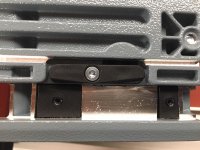As promised, I have tested the Festool rails with a Festool machine, the AG 125 De
Machine made in the Czech Republic
I have this machine since this past summer, it seems manufactured in July 2020, I have used it a couple of times but never on the Festool guidelines.
When testing the machine on the Festool guides I discovered that the rear plastic piece (in this case it is not a wheel but a piece of plastic and a screw) The screw has passed and it does not tighten the plastic piece against the guide. what the fastening is deficient.
A serious failure in quality control, I think it can be solved by changing the screw.
I'm sorry if someone has been offended or thinks their interests are affected but I have spent a lot more money on Festool tools than on tools from other brands and I can't help but feel disappointed, first of all with the Festool guides, good looking, many interesting accessories but the adjustment with the machines is not very good, it is not rigid and if you are not careful the cut can deviate
I am not saying that you cannot make straight cuts, what I am saying is that you cannot trust everything to the guide, it does not fit with enough rigidity to move the saw forward and not worry about applying a certain force on the machine to prevent it from the saw oscillates.
Because if someone buys these guides for approximately € 100, it is because they trust a perfect guide, since a straight cut can also be made by supporting the tool on an aluminum or wood guide for a much lower cost.
I have both systems and I am in a position to ensure that with the Mafell guides the oscillation is minimal, I have recorded a video with the saw on and using a lot of force, the oscillation is minimal and the applied force is great, so much that it displaces the guide itself. the surface, the rigidity is superior and therefore its precision is also.
I also understand that in this forum there are many users of Festool tools and rails and I am sure that there will be many happy users but I am not because I invested a lot of money in this system and after evaluating it with the competition I feel the disappointment of those who made a decision wrong.
The videos where the problem is appreciated:
https://dai.ly/x7yw0q8
https://dai.ly/x7yw0ue
The channel surface on Mafell / Bosch guides is much smaller so they can afford to make a much tighter hole without increased friction that makes the tool immovable.
Therefore, the problem with Festool guides is with the design of their channel and it could only be solved (without changing the shape of the guide) with bearings or some other complicated fitting system at the base of the tool, something that would make the product and it seems that Festool is rather looking at how to cut costs and not spend money on excellence that would inevitably drive up the price of its tools.
What if I ask please is that you do not offend me with insinuations, in this post it is about comparing both systems, there is no possible comparison, Mafell / Bosch guide systems are clearly superior and starting with the precision of guidance and rigidity, something fundamental, first of all.






